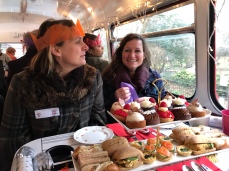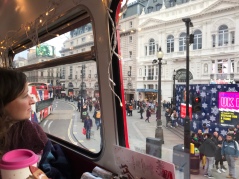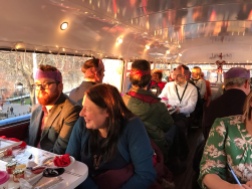Last week at UCL’s Engineering Front Office we celebrated birthdays, for my colleague Inês, and for me as well. A group of us had lunch out together on Wednesday and we also enjoyed lunch in the office together on several other days of the week.
It’s really not so bad getting old when you’re surrounded by loving friends! Even if they keep rubbing in my nearly-senior status….
At the end of the day, Friday, Aongus and I darted out of the city for a weekend away in historic and picturesque Oxford. This blog post recounts these birthday adventures using pictures.
Birthday Lunch at Sagar
On Wednesday, a group of us enjoyed a south-Indian lunch together at Sagar, which our lovely colleague, Sital Thanki, has introduced us to. In addition to a few photos of the birthday lunch, I show below some of the many kind cards and gifts I received from colleagues, friends, and family. The packages, calls from parents, and online messages I received from friends via Facebook and LinkedIn were also heartwarming.
Weekend in Oxford
As a birthday present, Aongus booked a weekend away in Oxford. We left London after work on Friday by bus (cheaper than the train, but with its own unique pitfalls). Overall, we enjoyed two nights in one of the world’s loveliest university cities before re-boarding a bus back to London.
Exploring the City
We ventured out briefly for dinner on Friday but focused on resting up for Saturday.
On Saturday morning, we wandered through the city fairly aimlessly. We wanted to see the high street areas, visit some of the shops, and get a feel for the University of Oxford.
Natural History Museum
On Saturday afternoon, we visited Oxford’s museum for Natural History, which I’d read about in one of Bill Bryson’s books. In addition to the exhibits on dinosaurs, mammals, birds, and insects, we also took in the special exhibit on bacteria. I’d need an extensive blog to tell you what I learned about bacteria, and I held off posting all the photos I took. But you’d be surprised to learn how bacteria created oxygen, photosynthesis, and cell-splitting that enabled human life to form.
Really amazing stuff!
Visiting this museum, you see the huge value that researchers add to our knowledge of everything in the physical world. Curious minds want to know! And many of these curious-minded people become life-long researchers–exploring the world to find answers to questions we didn’t even know we had, as well as questions we knew!
History of Science Museum
We narrowly missed the departure of the morning “Footprints” tour on Sunday, but we booked in for a later tour and headed into the History of Science Museum, originally a stockpile of curiosities, and now spread across three floors. My favorite parts covered sundials, photography, and penicillin–crucial research on penicillin was done at Oxford. Also fun were the measuring devices, calculating machines, and astronomical gadgets. Again, thank goodness for curious minds, figuring all this stuff out over time!
Blackwells Bookstore
To escape the cold–and take a little rest between the science museum and the planned walking tour–we stepped inside Blackwell’s Bookstore. A mindboggling collection indeed! It’s multiple floors and the basement sprawls far under Trinity College. Incidentally, at Oxford, the colleges are residential–they are where the students live, eat and sleep. Every student belongs to a college, and every student studies in a department.
Thankfully, Blackwell’s also features a coffee shop, which is optimal for a welcome and well-deserved rest.
Footprints Tour of Oxford
The Footprints company offers free walking tours as well as paid ones. To ensure we were part of a small group and could enter some Oxford sites where there are entry fees, I purchased tickets for the two-hour walking tour at £15 each. Although the plan seemed ideal, the weather turned ugly. Just before the tour started it got very cold, and shortly after the start, hail pounded down. The tour guide had to skip the first two sites and run straight into a library. Aongus was frozen solid by the tour’s end.
Divinity School
The large hall with its ornately carved stone ceiling at the Divinity School is featured in all sorts of films–from Harry Potter to the recent Mary Queen of Scots and The Favourite. Our tour guide brought us inside for a stop off–and I was thrilled to see this space.
New College: squares, dining hall, chapel and cloister
Of the 38 colleges at Oxford, we peeked inside only a few–they have entrance fees, and what you are permitted to see varies from one to the next. I wasn’t sure how to manage all that without insider knowledge, so we hired a guide! There were only ten of us in the tour group.
Our tour guide brought us to her favorite, the New College. You’ll likely recognize the dining hall, which is featured in movies. Of note, the cloister and the tree in it appeared in Harry Potter, but the dining hall used in that series of films was custom built, a near replica of a hall on campus that has only three actual long tables for the students. As Hogwarts had four schools, they made the studio version a bit wider to accommodate the extra row. Most college dining halls at Oxford also have a high table where the privileged sit and eat superior food.
The chapel in the New College is exquisite, and we heard a bit of organ practice while seated in there. Many colleges destroyed their historic old chapels and replaced them with more modern ones. What a waste. This Gothic one is stellar, though the ornate end wall was a somewhat recent addition.
Bodleian Library
Perhaps the most iconic building at Oxford is the round Bodleian Library, a reading room for students. Turns out, a cylinder isn’t quite conducive to storing books. It’s better for studying, we hope!
Overall, Oxford has a massive collection of books. This library is second only in size to the British Library (a copy of everything published in the UK goes there, similar to the Library of Congress in the USA, which is the world’s largest library collection). Like these other two libraries, you can view books only on-site here–it’s not a lending library.
Famous Folks
Oxford provided inspiration for C. S. Lewis’ Narnia and Tolkien’s Hobbits. Although I must admit I know little of Harry Potter, I did read some Hobbit stories and all of The Chronicles of Narnia.
Near the end of our tour, we saw the door that inspired Lewis’ lion, witch, and wardrobe. We also saw the Oxford lamp post he made famous.
We also learned about some very destructive and badly behaved boys who attended Oxford (David Cameron, Boris Johnson, and their political cronies). We learned about others who misbehaved in the town less aggressively (Bill Clinton) and we learned of people burned for political crimes on Broad Street, where our tour had started.
Look for the Footprints office there on Broad Street, near the shop Boswells of Oxford. Pick up some new luggage and an Ameribag while you’re there! It will take your mind off the stories of deviant behavior.
























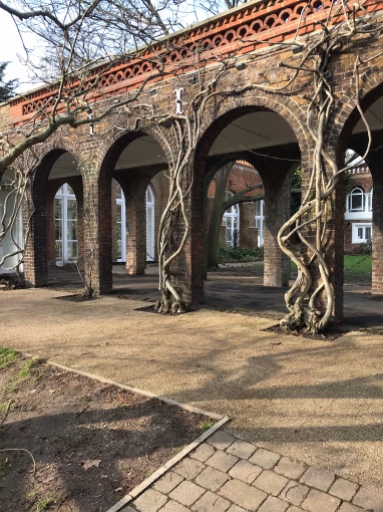


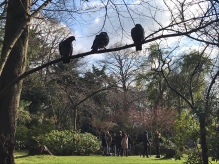









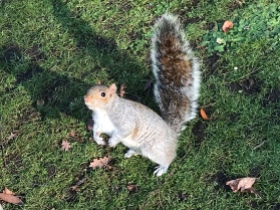


















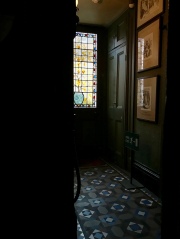































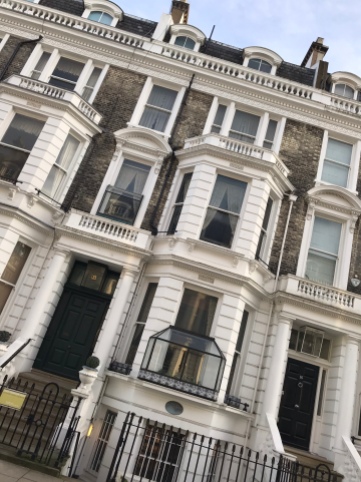

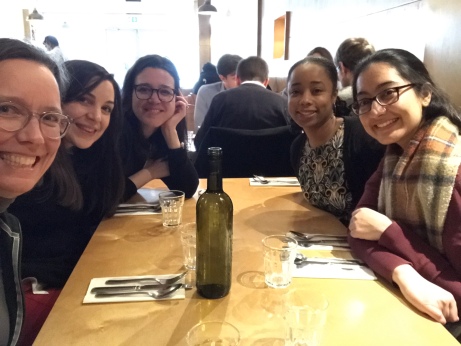




































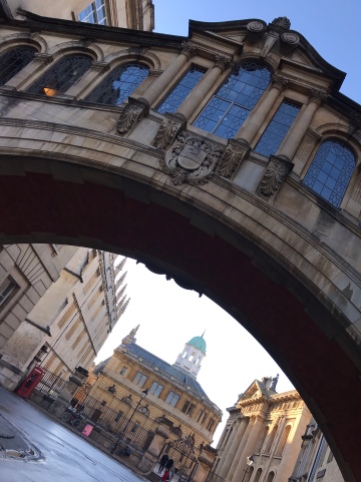



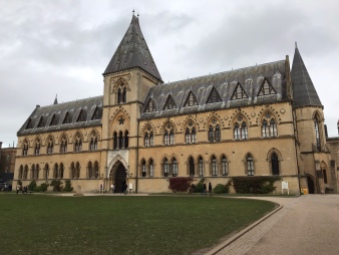

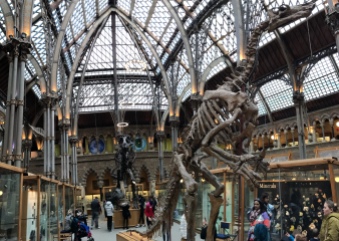





































































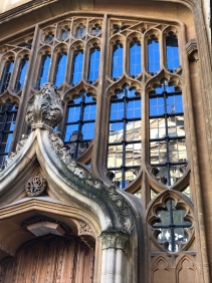





















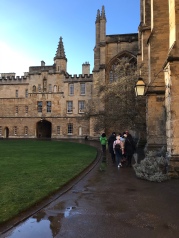



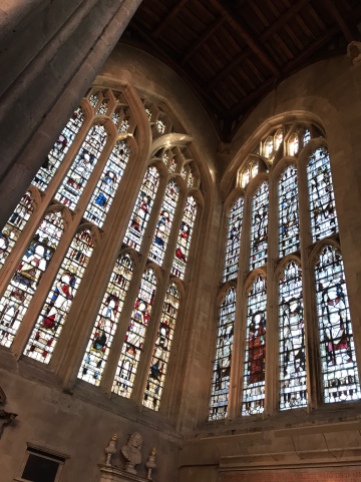






















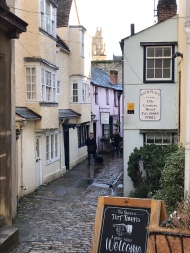



 Aongus and I stopped by the public library in Bethnal Green over the weekend since I wanted to show him its glorious architecture. It’s in the park we traverse en route to the Central Line Tube Station. The woodwork and the natural lighting in the reading rooms are superb.
Aongus and I stopped by the public library in Bethnal Green over the weekend since I wanted to show him its glorious architecture. It’s in the park we traverse en route to the Central Line Tube Station. The woodwork and the natural lighting in the reading rooms are superb. As such, I’m nearly finished reading the novel now. It is, as you probably recall from the contemporary motion picture by the same name, about a young Irish woman who boldly moves, alone, across the Atlantic to start a new life. I empathize with her experiences and I recognize many of the places she describes–both in Brooklyn and around Enniscorthy town and county Wexford, her original home. I’ve enjoyed both the book and the feature film but have learned more about Ireland form the book.
As such, I’m nearly finished reading the novel now. It is, as you probably recall from the contemporary motion picture by the same name, about a young Irish woman who boldly moves, alone, across the Atlantic to start a new life. I empathize with her experiences and I recognize many of the places she describes–both in Brooklyn and around Enniscorthy town and county Wexford, her original home. I’ve enjoyed both the book and the feature film but have learned more about Ireland form the book.
















 I’ve been spell bound all day by Dayan Sudjic’s 2016 book, “The Language of Cities.” I purchased the book after work yesterday to keep my knowledge of city-building fresh and up-to-date. I made that find at Waterstones, across the street from my office in Bloomsbury, and sealed the deal with a £10 gift card I won at Christmas.
I’ve been spell bound all day by Dayan Sudjic’s 2016 book, “The Language of Cities.” I purchased the book after work yesterday to keep my knowledge of city-building fresh and up-to-date. I made that find at Waterstones, across the street from my office in Bloomsbury, and sealed the deal with a £10 gift card I won at Christmas. The Faculty if Engineering held a team-building event for Christmas, aboard a private double-decker bus that toured around the city of London. I got to know other members of our faculty as I sat with three people I didn’t previously know. Our table of four formed a team for the trivia contest, developed by our Dean’s personal assistant, the marvelous Maria Speight. Maria invented all the questions, having to do mostly with the sights we were passing. Excelling in this game required in-depth knowledge of the history of this fine city, which dates back to Roman times.
The Faculty if Engineering held a team-building event for Christmas, aboard a private double-decker bus that toured around the city of London. I got to know other members of our faculty as I sat with three people I didn’t previously know. Our table of four formed a team for the trivia contest, developed by our Dean’s personal assistant, the marvelous Maria Speight. Maria invented all the questions, having to do mostly with the sights we were passing. Excelling in this game required in-depth knowledge of the history of this fine city, which dates back to Roman times. What a great way to spend a day before Christmas, on a sunset tour of a glorious city, surrounded by passionate people who love their work in academia. I am truly blessed!
What a great way to spend a day before Christmas, on a sunset tour of a glorious city, surrounded by passionate people who love their work in academia. I am truly blessed! Sudjic’s book is full of insight, making fascinating new connections, so the synapses in my brain have been firing furiously today! Sudjic makes plenty of reference to the history and operation of London as well as cities around the world, and I am connecting the principles to places I’ve been.
Sudjic’s book is full of insight, making fascinating new connections, so the synapses in my brain have been firing furiously today! Sudjic makes plenty of reference to the history and operation of London as well as cities around the world, and I am connecting the principles to places I’ve been.





